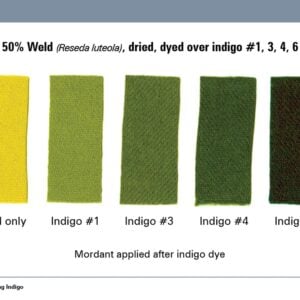Our cochineal insect instructions will help extract color from cochineal insects, native of Mexico and South America. These scale insects produce carminic acid and are a traditional way of obtaining bright red, brilliant pink, and purple dyes. It is the only natural red color that was approved by the Food and Drug Administration for food and cosmetic use and is often used as the substitute for the notorious Red Dye #2.
Fiber Preparation and Mordanting
We offer scouring instructions for wool, alpaca, silk (protein), cotton and plant (cellulose) fibers on these How To pages. When dyeing with cochineal, protein fibers mordanted with aluminum sulfate alone create reddish purple shades, and protein fibers mordanted with alum and cream of tartar yield fuchsia to red shades.
How Much Cochineal to Use?
Use the table below as a guideline for achieving light, medium and dark shades. In all cases, you may be able to dye additional fabrics or yarns with the exhaust dye bath, so don’t throw it out and have some extra mordanted fibers ready once you have dyed your initial color.
| Depth of shade | Amount of cochineal as a percentage of the weight of fiber (WOF) | Notes |
| Light | 1-2% WOF | Exhaust dye bath will dye additional fibers a very pale shade of pink. |
| Medium | 3-5% WOF | Exhaust dye bath will dye additional fibers a pale shade of pink. |
| Dark | 6-10% WOF | Exhaust dye bath will dye additional fibers a light shade of pink. |

Addition of Iron
Iron will shift cochineal to purple. You can use a tiny amount (1/16th of a teaspoon or a pinch up to 1/8th teaspoon for approximately 1 pound/454 grams of fabric) dissolved in cold water and added to the dye bath before dyeing. Iron is extremely potent and changes the color immediately, so use sparingly.
Addition of Cream of Tartar
Adding up to 5% WOF (2 tablespoons Cream of Tartar for approximately 1 pound/454 grams of fabric) into the dye bath will shift the color from a reddish purple to a vivid flag red.
How Much Water to Use?
The amount of water to use in the extraction process varies according to the size of your dye pot and the amount of bugs you have, but keep in mind that the liquid you are making is your dye bath, so use less water than the total capacity of your dye pot. The object is to get as much color as possible out of the bugs. You may also dry the pulp and save it for eco-printing.
Extracting the Dye
- Measure the bugs and grind in a coffee or spice mill to a powder.
- Place the ground cochineal powder with 1/2 to 1 quart of non-mineralized (distilled) water in a non-reactive (stainless steel or enamel) saucepan and bring to a boil. Add cream of tartar as indicated in the table above and boil for 10-15 minutes.
- Using a cheesecloth and strainer, strain the colored dye solution into a non-reactive vessel like a 5-gallon bucket and reserve the bug pulp.
- Place the pulp in the saucepan with fresh water and repeat Step 2. Strain this second solution into the bucket.
- Repeat Step 2 until the bugs are no longer yielding much color (the dye solution will be light pink). Usually, this takes 3-4 extractions.
- The reserved bright red liquid is your dyebath. Pour the dyebath into a dye pot and proceed to dyeing. There is usually enough cream of tartar in your dye bath at this time to create a beautiful vibrant fuchsia. If you want a flag red shade, add a bit more cream of tartar to the dye bath. If you want a more purple shade, add dissolved iron to the dye bath.
Adding Fibers to the Pot
Fill the dye pot with water so that the fibers move easily. Add the extracted liquid and stir well. Add the wet, mordanted fibers to the cold dye pot and begin heating the water and bring to about 90 degrees F (33 degrees C), rotating the goods gently. Hold at this warm temperature for 30 minutes, then bring the temperature up gradually to 180 degrees F (80 degrees C), rotating gently. Hold at this temperature for 30-45 minutes rotating regularly.
Rinsing
Using the same temperature water as your fiber, rinse the dyed goods once or twice to remove excess dye, then wash gently in a neutral liquid soap. Dry away from direct sunlight.
Reusing Dye Baths and Disposal of Dye
Any exhaust baths with dye color left in them may be used to dye additional materials. I keep extra small skeins of mordanted wool yarn and throw those into the exhaust baths. There will usually be some residual color in the dyebath, even after using the exhaust bath. Dispose of the used dye baths in accordance with your local municipal guidelines.
For additional questions on our Cochineal Insect Instructions, please contact [email protected].




